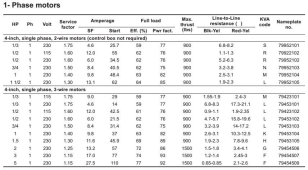offgriddle
"FOREVER BEGINNING"
I never even considered that a pair of beefy looking MPP inverters creating a combined of 4,800 watts could falter in the face of surge current even if it's less than 4,800 watts. This is valuable information to consider when growing my solar power system, thank you all.
| Size of Pump Motor | Running Wattage | Starting Wattage |
| 1/3 HP | 750 to 800 | 1,500 to 2,400 |
| 1/2 HP | 900 to 1,050 | 1,800 to 3,150 |
| 3/4 HP | 1,500 to 1,800 | 3,000 to 5,400 |
| 1 HP | 2,000 to 2,400 | 4,000 to 7,200 |
| 1.5 HP | 2,500 to 2,800 | 5,000 to 8,400 |
| 2 HP | 3,750 to 4,000 | 7,500 to 12,000 |
| 3 HP | 5,000 to 5,500 | 10,000 to 16,500 |
| 5 HP | 7,500 to 8,000 | 15,000 to 24,000 |
| 7.5 HP | 10,000 to 11,000 | 20,000 to 33,000 |
| 10 HP | 15,000 to 16,000 | 30,000 to 48,000 |
Last edited:





